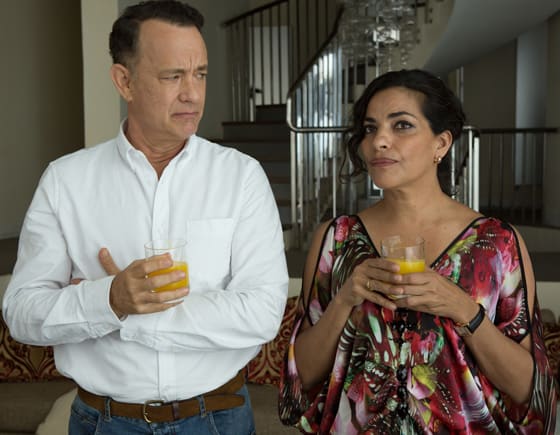Credit Tom Tykwer (Cloud Atlas, Run Lola Run): A Hologram For the King is one of the few movies that doesn't show the Middle East as a desolate wasteland of extremism and violence.
Based on the Dave Eggers book of the same title, the film centres on Alan Clay, a Bostonian salesmen played by Tom Hanks. Sent to the Kingdom of Saudi Arabia with the task of selling the King on a new IT system, Clay is forced to navigate the obstacles and make the sale. Despite all the usual false starts resulting from the comedic tropes of culture shock, he meets and falls for his doctor, Zara Hakim, played by Sarita Choudhoury.
The plot is jerky; it muddles presumably important back-stories and introduces characters that drive the narrative in reverse. If anything, the only thing underpinning the whole film is an appreciation for design aesthetic in the Middle East, with sharp angles and beautiful mosaics serving as the background for many scenes.
Trying to appear informed, the film still manages to mangle an understanding of regional politics. The Saudi King can't meet Clay because he's in Yemen for a royal visit — yes, the same Yemen that Saudi Arabia has continuously bombed for the last year. It doesn't help that for a movie set in the Middle East, very few of the main cast members are of Arab descent.
There's a scene where three young men, clad in white dishdasha and chequered keffiyeh, excitedly talk to each other in Arabic. The audience wonders, "What is the cause of this excitement?" The camera pans down, and they're playing a game on an iPad. Cut to a bemused Tom Hanks. Get it? Because they're different.
More frustrating than the narrow conception of the region here is that there are moments, however brief, when the writers get it tantalizingly right. They manage to highlight the fascinating contradictions of ambition checked by desert: all progress, no matter how glossy and clean, is covered with a thin layer of dust. As Clay passes through a condo development, stepping gingerly over unfinished concrete stairs and cast aside tools, he enters a pristine room that belies the skeletons of construction around it. This short vignette is a telling insight into the rapid development of gated communities built in the desert, a stretch of empty structures speckled by the occasional fully operational unit, making for a visual and conceptual absurdity.
This phenomenon is familiar to residents not only in Saudi Arabia, but also the United Arab Emirates and Egypt. But, just when the film shows an appreciation expanding the visual understanding for the nuanced contradictions of Saudi Arabia, it quickly reverts to jokes about camels crossing the road.
(eOne)Based on the Dave Eggers book of the same title, the film centres on Alan Clay, a Bostonian salesmen played by Tom Hanks. Sent to the Kingdom of Saudi Arabia with the task of selling the King on a new IT system, Clay is forced to navigate the obstacles and make the sale. Despite all the usual false starts resulting from the comedic tropes of culture shock, he meets and falls for his doctor, Zara Hakim, played by Sarita Choudhoury.
The plot is jerky; it muddles presumably important back-stories and introduces characters that drive the narrative in reverse. If anything, the only thing underpinning the whole film is an appreciation for design aesthetic in the Middle East, with sharp angles and beautiful mosaics serving as the background for many scenes.
Trying to appear informed, the film still manages to mangle an understanding of regional politics. The Saudi King can't meet Clay because he's in Yemen for a royal visit — yes, the same Yemen that Saudi Arabia has continuously bombed for the last year. It doesn't help that for a movie set in the Middle East, very few of the main cast members are of Arab descent.
There's a scene where three young men, clad in white dishdasha and chequered keffiyeh, excitedly talk to each other in Arabic. The audience wonders, "What is the cause of this excitement?" The camera pans down, and they're playing a game on an iPad. Cut to a bemused Tom Hanks. Get it? Because they're different.
More frustrating than the narrow conception of the region here is that there are moments, however brief, when the writers get it tantalizingly right. They manage to highlight the fascinating contradictions of ambition checked by desert: all progress, no matter how glossy and clean, is covered with a thin layer of dust. As Clay passes through a condo development, stepping gingerly over unfinished concrete stairs and cast aside tools, he enters a pristine room that belies the skeletons of construction around it. This short vignette is a telling insight into the rapid development of gated communities built in the desert, a stretch of empty structures speckled by the occasional fully operational unit, making for a visual and conceptual absurdity.
This phenomenon is familiar to residents not only in Saudi Arabia, but also the United Arab Emirates and Egypt. But, just when the film shows an appreciation expanding the visual understanding for the nuanced contradictions of Saudi Arabia, it quickly reverts to jokes about camels crossing the road.
